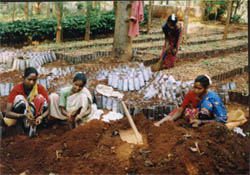SERICULTURE
In 1989, from two villages 13 people 11 women 2 men received assistance to undertake a sericulture programmed The assistance was provided from a worked bank project through the block development office under a schemer called economic rehabilitation of the rural poor. Through the sericulture programmed women were made to be the owner of the land, in one village, 16 women were selected for training in 1993. After training in mulberry farm management, rearing of cocoons, rearing of silk yarns the women took sericulture in 16 acres. usually men would undertake the sericulture programmes, so this was a challenge for the women.
|
|
|
In 1995 farmers from Kondhi plunger received assistance for construction of rearing rooms from national sericulture project. with the help on the engineer the farmers planned a low cost rearing house which was built with the financial assistance from NSP. In one village, with the help of NSP, 5 acres of mulberry plantation was undertaken. During 1998 the staff followed up the sericulture programme in three villages and three new villages were approached by the people to the project to initiate mulberry plantation. The staff continuously visits the villages and generates awareness on the economics of sericulture. the block development extended support to the farmers on mulberry cultivation and processing the application for assistance. MRCS extended technical guidance and cocoon marketing and supplied with DFLs and mulberry cuttings.
Mulberry Rearing Programme
A new demonstration field was developed at field office campus for research and training purpose. To develop the field a nursery was raised on varieties like 1370, K2 mulberry cuttings. IN pit system totally 6,000 plants of tree types and 3000 plants in row system were planted. In nursery, 2 000 plants were developed.
In 1999 the staff developed one acre of mulberry plantation at IRDWSI campus for demonstration and research. The demonstration field was introduced in four varieties (S 24, S 30, M 5 and 17 30) They are introduced in three types of plantation (Tree type, Row and Pit System). The team developed castor plantation and inter crop for commercial and research purpose. Commercially 3 silk worm rearing and 2 Eri readings were taken up. A research study was made on variedly of leaves i.e. M5 and 1730 variedly on life field. More cocoon Yield and leaf moisture on different varieties. it was observed on commercial rearing at central level on notary (PM) race has given good result and the DELLS were produced from mulberry research center at potting Govt. of orison. A central demonstration rearing was organized on Eri and See. During 1998, 3 crops of ERI and 1 Crop of seri were organized to train the farmers. The mulberry leaf and seed was supplied by MRCS< potting. A study was undertaken on ERI and Seri. The total yield of Eri cocoon and Seri was 28 Kg. The sericulture co-coordinator organized a cellular rearing with 10 DFLS. They observed a good result in cellular rearing on less leaf consumption and more cocoon yield. The farmers in one village were supported by National sericulture project, Karafuto during 1996 to undertake a mulberry rearing programme. In this village the community selected small farmers (Male 2 and female 3 to plant mulberry in one acre. NSP was supported to each farmer of Rs.12,000/- as a grant. The farmers contributed bricks and labor.
The selected land was wasteland form, which they were getting one croup of oil seeds annually . The staff along with the farmer planned and converted the piece of land for mulberry plantation. The organization supplied them variant of K2 (M5). The plantation system is 3/3 spacing pit system.
Castor Plantation
As the castor plants are largely available in the area, the people are rationally using the castor oil for different purposes like fever, head and coolness. The farmers in one village started rearing on Sericulture and now the farmers are using the seeds for oil purpose selling g in the market and rearing cocoons.



